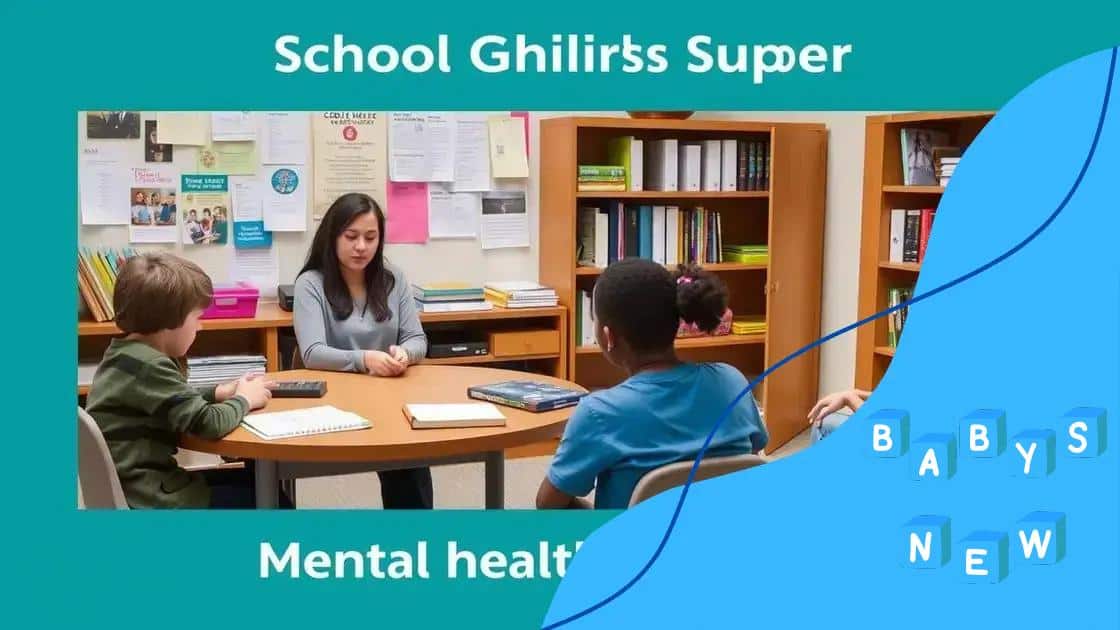School mental health funding: why it matters now more than ever

Advertisement
School mental health funding is essential for providing necessary support services that enhance student well-being, improve academic performance, and address emotional challenges effectively.
School mental health funding is essential for creating a supportive environment where students can thrive. Have you ever wondered how adequate funding could transform a school’s mental health approach?
Understanding the importance of mental health in schools
Understanding mental health in schools is vital for creating an environment where students can learn and thrive. It’s not just about academics; a student’s emotional well-being is equally important. When schools prioritize mental health, they foster better learning outcomes and build a supportive community.
The Impact of Mental Health on Learning
Mental health plays a crucial role in a student’s academic journey. Studies show that when mental health is prioritized, students perform better. They have improved focus, enhanced memory, and increased motivation. This leads to greater academic success.
Advertisement
Common Mental Health Issues in Schools
- Anxiety: Many students face anxiety, which can hinder their ability to participate and focus.
- Depression: Depression can affect attendance and academic performance, making it important to address.
- Behavioral Issues: Without proper support, students may exhibit disruptive behaviors that can disrupt learning for themselves and others.
Schools must recognize these challenges. By creating a safe and supportive environment, they can help alleviate some of the pressure students face. Providing resources and support is crucial for helping students cope. The benefits of a strong mental health program extend beyond the classroom; they build a foundation for healthier lives.
Additionally, engaging students in open discussions about mental health can help break down stigma. When students feel safe discussing their feelings, they are more likely to seek help when needed. Encouraging conversations can lead to stronger peer support networks, which are essential for emotional resilience.
Another essential aspect is training teachers to recognize signs of mental health issues. They often see students daily and can spot changes in behavior. With proper training, they can intervene early, providing help before issues escalate.
Advertisement
Incorporating mental health education into the curriculum is also beneficial. Teaching students about mental health helps them understand their own emotions and recognize those of others. It’s a valuable skill that can benefit them throughout their lives.
Overall, understanding the significance of mental health in schools is the first step toward fostering a supportive educational environment. By prioritizing mental well-being, schools can help students reach their full potential.
Current funding levels and their impacts
Understanding the current funding levels for mental health in schools gives insight into the challenges and opportunities that exist. Funding affects how schools can support their students’ emotional well-being, and it plays a crucial role in shaping their mental health programs.
Where Does Funding Come From?
School mental health funding typically comes from various sources, including federal, state, and local governments. Each source has its own priorities and limitations, which can impact the amount of money available for mental health resources.
- Federal Funding: Programs like the Substance Abuse and Mental Health Services Administration (SAMHSA) provide funds specifically for school mental health initiatives.
- State Funding: States allocate budgets based on their educational priorities and needs, which can vary widely.
- Local Funding: Local districts may raise funds through taxes or community support, but these resources can be limited.
The distribution of these funds is often uneven. Schools in wealthier areas may receive more funding compared to those in low-income neighborhoods, leading to disparities in access to mental health services.
The Impact of Insufficient Funding
When funding is low, schools face significant challenges in meeting the mental health needs of their students. This can result in fewer counselors and resources available to help those who are struggling. As a result, students may experience longer wait times for services, or they may go without necessary support altogether.
Additionally, low funding can affect the quality of mental health programs. Schools need trained professionals to provide effective support, and without adequate funding, they may struggle to hire or retain qualified staff. This has a direct impact on students who rely on these services.
Moreover, insufficient funding can contribute to a lack of awareness about mental health. Schools may not be able to offer the education or resources necessary for students to understand and manage their mental health effectively.
On the other hand, when schools receive adequate funding for mental health initiatives, they can create comprehensive programs. These programs often include prevention and intervention strategies designed to support students before issues escalate. With the right funding, schools can foster an environment where students feel safe and supported.
As we explore the implications of current funding levels, it’s clear that prioritizing mental health funding is essential for creating thriving school communities. By addressing funding gaps and ensuring equitable access to mental health resources, we can help all students succeed.
Effective allocation of mental health resources

Effective allocation of mental health resources in schools is crucial for supporting students’ emotional well-being. When these resources are distributed wisely, they can drastically improve the mental health landscape within educational institutions. Understanding how to allocate these resources effectively can lead to better outcomes for students.
Assessing Needs
The first step in effective allocation is assessing the specific mental health needs of the student population. Schools should start by gathering data through surveys, focus groups, and consultations with mental health professionals. This process helps identify what services are most needed, whether counseling, workshops, or educational programs.
Prioritizing Resources
Once needs are assessed, schools can prioritize their resources. Schools may look into the following categories:
- Counseling Services: Hiring enough licensed counselors to ensure students have access to one-on-one support.
- Preventive Programs: Implementing programs that teach coping skills and resilience before issues arise.
- Training Staff: Providing training to teachers and staff on identifying and addressing mental health issues.
By focusing on these areas, schools can create a strong framework for supporting student mental health effectively.
Another important aspect of allocation is ensuring accessibility. Resources must be available to all students, regardless of their background. This can involve providing translations for non-English speaking parents or offering services in various formats, such as online counseling, to cater to students who might not be able to access in-person sessions.
Moreover, schools should create partnerships with community organizations to enhance the availability of resources. Collaborating with local mental health providers can expand services and provide students with additional support systems. These partnerships often offer expertise that schools may not have in-house.
Finally, funding will influence how resources are allocated. Schools need to advocate for increased funding from government or private sources. By showing how effective allocation of mental health resources can improve student outcomes, schools can make a compelling case for the support they need.
Success stories: schools that improved mental health funding
Success stories from schools that improved mental health funding showcase the positive impact such changes can have on students and communities. By increasing funding, these schools created programs that significantly enhanced the support available to students.
Case Study 1: Lincoln High School
At Lincoln High School, administrators recognized a rise in student anxiety and depression. With increased funding, they hired additional counselors to reduce the student-to-counselor ratio. This change allowed students to receive more personalized attention, leading to a noticeable decrease in behavioral issues.
Case Study 2: Maplewood Academy
Maplewood Academy implemented a comprehensive mental health program after boosting funding through community partnerships. They introduced workshops aimed at building resilience and coping skills among students. These workshops equipped students with the tools they needed to handle stress, resulting in improved academic performance.
Case Study 3: Oak Street School
- Peer Support Programs: Oak Street School developed peer support programs, where trained students act as mental health ambassadors.
- Community Engagement: They involved parents and local organizations in mental health education initiatives.
- Resource Allocation: The school allocated funds specifically for training staff in mental health first aid.
This holistic approach helped create a safe and supportive environment for all students at Oak Street, lowering instances of bullying and increasing overall student satisfaction.
The success of these schools highlights the importance of advocating for mental health funding. Their experiences demonstrate that with the right resources, schools can make profound and lasting improvements in student well-being. Enhanced funding not only helps in addressing immediate mental health needs but also lays the groundwork for a healthier and more supportive learning environment.
Future trends in school mental health financing
Future trends in school mental health financing reveal a growing awareness of the importance of mental well-being in education. As schools recognize the impact of mental health on student success, funding strategies are evolving to meet these new demands.
Increased Government Support
Governments are beginning to allocate more resources specifically for mental health initiatives. Federal and state grants are increasingly available, allowing schools to implement new programs and hire qualified staff. This financial support is crucial for bridging the gap in resources.
Collaborations with Nonprofits
Another trend is the collaboration between schools and nonprofit organizations. These partnerships can enhance funding and provide specialized services. Nonprofits often have the expertise and programs necessary to effectively support students.
- Grant Writing Assistance: Many nonprofits help schools apply for grants.
- Resource Sharing: Schools can access tools and training that they might not be able to afford alone.
- Community Engagement: Nonprofits often connect schools with local communities, raising awareness and additional funds.
As schools engage with these organizations, they expand their ability to address mental health challenges effectively.
Additionally, technology is changing the landscape of mental health financing. Online platforms for mental health resources are becoming more popular, allowing schools to access materials and training without the high costs associated with in-person programs. These technologies provide flexible options that can adjust to individual school needs.
Schools are also focusing on preventive measures as part of their financing strategies. By investing in early intervention programs, they can address mental health issues before they escalate. These proactive approaches not only improve student well-being but also save money in the long run.
Lastly, the conversation around mental health is shifting towards inclusivity. Schools are becoming more aware of the diverse needs of their students. Financing will increasingly be targeted towards culturally responsive programs that recognize and serve various student backgrounds, ensuring equitable access to mental health resources.
In conclusion, prioritizing mental health funding in schools is essential for supporting student well-being. With increased awareness, collaboration, and innovative funding strategies, schools can create environments where students thrive. By investing in mental health, we can build a brighter future for all students, ensuring they have the support they need to succeed academically and emotionally.
FAQ – Frequently Asked Questions about School Mental Health Funding
Why is mental health funding important in schools?
Mental health funding is crucial for providing support services that help students cope with challenges, leading to better academic performance and emotional well-being.
How can schools secure more funding for mental health?
Schools can apply for government grants, collaborate with nonprofits, and engage with community organizations to increase access to funding.
What innovative strategies are being used to allocate mental health resources?
Innovative strategies include using technology for online programs, focusing on preventive measures, and ensuring cultural inclusivity in mental health services.
What are some success stories related to improved mental health funding?
Success stories include schools that have hired additional counselors and implemented programs that significantly reduced student anxiety and improved overall mental health.





